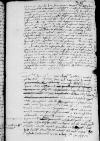List #1749
[Ioannes DANTISCUS] do [Johann TYMMERMANN]Löbau (Lubawa), 1537-10-19
Rękopiśmienne podstawy źródłowe:
Publikacje:
| ||||||
Tekst + aparat krytyczny + komentarzZwykły tekstTekst + komentarzTekst + aparat krytyczny
Venerabilis Domine, Frater et Amice carissime. Salutem et omnem felicitatem.
Accepi 1537-10-18⌊heri1537-10-18⌋ ab hoc domino

 BCz, 244, p. 269
BCz, 244, p. 269